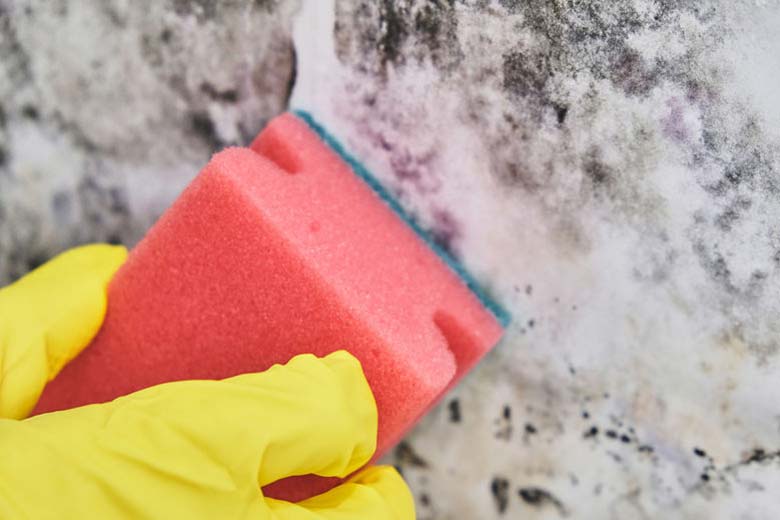Concrete is one of the favorite options when constructing floors and walls because it’s durable, chemically inert, and easy to clean. However, it’s porous and sometimes soaks up dirt and harbors mold. Because of that, you need to occasionally clean concrete surfaces to spruce them up.
The best ways to clean concrete basement walls include tri-sodium phosphate, vinegar, and hydrogen peroxide. Some are versatile, as you get a cleaner, a fungicide, and a bactericide in one substance. They do not damage concrete but help to break down stubborn stains, such as grease and grime.
This article will discuss the concrete basement stains you’re likely to encounter on your walls, the importance of pre-cleaning basement walls, and the best methods of cleaning your walls. Also, read on for more details on protecting yourself when using some of the effective cleaning solutions.

Table of Contents
The Most Common Basement Wall Stains
Basement wall-stains are not just an eyesore as they may also contain mold or mildew, which impacts air quality and the health of you and your family. It can cause respiratory illnesses and make your air quality poor.
Although not all stains are mold, most of them point to the infiltration of your concrete walls by groundwater. Engineers often rely on adequate foundation drainage to prevent the problem, but if the soil surrounding the walls isn’t sufficiently dry, wall stain becomes a recurrent problem.
You’ll need to recognize the common basement wall-stains so that you can deal with them appropriately. Using the wrong cleaning products to clear a specific stain can cause more problems, including unnecessary health risks.
Here are some wall-stains you’re highly likely to encounter on your basement concrete:
A White Powdery Substance Called Efflorescence
Have you ever seen a concrete wall that has turned white, with a powdery substance developing on the wall? The substance is called efflorescence, which is a loose mineral salt that’s deposited by groundwater that infiltrates concrete surfaces.
Although it’s unsightly, it shouldn’t be cause for alarm, as efflorescence is harmless. However, it’s a sign of highly humid concrete, a problem that you must address immediately.
If unchecked, high-level humidity might cause severe problems, including the growth of mold in your basement.
Efflorescence can be removed using Eco-Etch Pro Concrete Etcher & Cleaner (link to Amazon), which is a 100% biodegradable, non-toxic, and VOC-free product with a good reputation.
This video provides more information on basement efflorescence:
Reddish/Orange Stains
Reddish/orange stains are a telltale sign of rust. Your concrete walls are highly likely to get infiltrated by iron ochre if you live in an area with high iron content in the soil. The ochre is carried by the groundwater that seeps into your basement walls.
Read more: Rust Stains on Concrete: Causes, prevention, and repair info
Although iron ochre is harmless to your health, it can build up in your waterworks systems and cause clogging. Also, ridding your surfaces of iron ochre can be a hassle since it stains almost everything, including plastic and carpeting.
You can remove these stains from concrete walls using this non-toxic, effective Singerman Laboratories Rust Remover for Concrete from Amazon.
Dark Black or Grey Stains
If you’ve spotted dark black or grey stains on your walls, chances are high that you have a mold problem to deal with.
Mold develops in highly humid, warm environments. It also indicates there’s organic matter in your walls since mold mostly feeds on them.
To keep mold at bay, you need to control one of the factors that promote their growth, including keeping your basement’s humidity lower than 60%.
Chipping and Flaking Materials
When building basement walls, you might be tempted to cover the concrete walls and make them water-resistant and airproof by using coatings, such as sealants, hydraulic cement, and paints. You also might want to spruce your walls up.
However, as water infiltrates your walls, pressure tends to build up under these coatings. The outcome is the caving in the coatings, which creates a mess as the paint chips fall all over your basement’s floor.
Therefore, you probably don’t want to apply any paint or sealant to your basement wall. They’ll most likely cause a mess that will be costly to remedy, as it can get expensive or labor-intensive to scrape, sand, and power wash your walls because of chipping and flaking.
But there are ways to paint on concrete and make it last. You just have to make it right.
Spalling or Crumbling Walls
Spalling occurs when the concrete in your basement wall begins to crumble, while also causing flaking and chipping. However, spalling is a more serious problem that you must address immediately. If you fail to do that, you may have to replace the entire concrete wall.
Just like some other stains, spalling results when water penetrates your wall. If the water carries salt, it may fill the spaces between concrete particles.
When the salt expands, they increase these spaces, causing the concrete to break and flake away. Therefore, keeping humidity levels low is one of the sure-fire ways of avoiding this problem.
This video explains how you can minimize humidity in your basement and garage:
Why You Should Pre-Clean Your Basement Walls
You should never rush when cleaning concrete walls. The first step you should take is to remove any buildup of dirt, debris, and cobwebs from your wall.
Begin at one corner and work your way across, diagonally, and vertically until you remove all dust and dirt. After that, you may proceed with any of the methods described below.
Use Trisodium Phosphate
Trisodium phosphate (TSP) is one of the most popular cleaning agents, thanks to its alkaline property and high water solubility.
To clean your concrete walls using TSP, you need:
- 1 gal (3.8 l) warm water
- 3 oz (85 g) TSP
- A bucket
- A wire brush
Once you’ve gathered the items, follow these steps:
- Spray the concrete wall with water, then scrub it with the wire brush to loosen up the dirt.
- Hose off the wall to rinse.
- Pour water and TSP into the bucket and mix them thoroughly.
- Spray the solution onto stained areas of the wall and scrub the stains using the brush.
- Rinse the wall with fresh water.
- Open your basement’s windows and doors for proper ventilation so your walls can thoroughly dry.
I can recommend using TSP Tri-Sodium Phosphate All Purpose Cleaner from Sunnyside, available on Amazon.com.
Kill Mold on Non-Porous Surfaces With Bleach
You can apply bleach to remove stains, mildew, and moss from your walls, as it’s an effective disinfectant and does not damage concrete.
To make a bleach cleaning solution, you need:
- 1 cup bleach
- 1 gal (3.8 l) water
- Spray bottle
- Sponge
- A bucket
Dilute one cup of bleach with at least one gal (3.8 l) water, then spray or wipe the solution onto the areas of your concrete basement wall covered in mold.
Caution: Wear rubber gloves, a respirator, and eye protection when using a bleach solution to clean surfaces. Never mix the solution with ammonia or vinegar, as the reaction can be toxic and dangerous. Also, ensure the basement is well-ventilated to avoid getting overwhelmed by fumes.
Clean Your Concrete Wall Using Ammonia
Did you know that you can make a cement cleaner using ammonia?
Ammonia is one of the best concrete cleaners since it quickly breaks down grease and grime. Therefore, you can rely on it to remove stubborn stains.
Here’s what you need to create an ammonia-based concrete cleaner:
- Dish detergent
- Warm water
- ¼ cup (59.15 ml) ammonia
- A bucket
- A stiff nylon brush
To make the solution, mix ¼ cup (59.15 ml) ammonia, a few squirts of detergent, and water in the bucket. Using the nylon brush, scrub the solution from one end of your wall to the other until you’ve covered the entire surface. After that, hose off the wall and dry it with a clean towel.
Tip: Ensure your basement is well-ventilated when using the ammonia solution by fully opening all windows and doors.
Clean Your Wall With Muriatic Acid
Muriatic acid is one of the best cleaners, especially when you need to remove tough stains.
To prepare its solution, you need:
- 4 gal (15.1 l) water
- 1 gal (3.8 l) muriatic acid
- A 5-gal (18.9 l) bucket
- A stiff bristle brush
To clean your concrete wall, follow these steps:
- Mop the wall, then let it dry completely.
- Mix the acid and water in the bucket.
- Scrub the wall with the solution.
- Mop the wall afterward at least twice to remove any residue.
Note: Muriatic acid is highly toxic. Ensure your basement is properly ventilated, and put on a respirator, goggles, and rubber gloves when using this cleaner.
Use Hydrogen Peroxide To Remove Molds
Hydrogen peroxide is one of the most versatile cleaners. You get a bactericide, virucide, and fungicide in one substance, and it has dozens of applications at home. It is an effective disinfectant, as it kills virtually all microorganisms, with mold being no exception.
If you want to use this method, here are the items you must first gather:
- A spray bottle
- 3% hydrogen peroxide solution
- A bristle brush
To kill the mold on your wall:
- Pour the hydrogen peroxide solution into the spray bottle and saturate the walls with the solution.
- Let it settle for 30 minutes.
- Using the brush, scrub the wall thoroughly to lift any residual mold out of the concrete pores.
- If possible, use a hose to spray the walls with clean, warm water, which leaves the walls shiny while removing clung-on spores.
- Dry the walls with a clean towel afterward, as this eliminates water spots that could encourage mold growth.
Use a Borax Solution
You need a detergent that can easily penetrate grease and grime when cleaning a cemented surface. Borax or sodium borate, an emulsifier, is one of the detergents designed to do precisely that.
To make the solution, you need:
- ½ cup (118.29 ml) borax
- 1 gal (3.8 l) water
- ½ cup (about 115.20 g) washing soda (not to be confused with baking soda)
- 1 tablespoon of liquid dishwashing detergent
- A bucket
- A long-handled brush
Once you’ve gathered the items, follow these steps:
- Mix the ingredients in the bucket.
- Using the long-handled brush, agitate the mixture for 3-4 minutes.
- For easy application, you can use a spray bottle. If you notice the solution settling, shake the bottle to remix it.
- Scrub the moldy surfaces on your concrete basement wall.
- Spray the borax solution on the surface and let it settle for a little while. You may not want to wash it off since it will inhibit mold growth.
Kill Mold Using Vinegar
Vinegar is one of the safest cleaners you can use to kill any mold growing on your concrete basement wall. Although this mild acid doesn’t have a pleasant smell, it’s one of the sure-fire disinfectants available.
To make the cleaning solution, you need:
- White vinegar
- Baking soda and water solution
- A spray bottle
To clean your concrete using vinegar:
- Generously spray the spots with mold with undiluted white vinegar.
- Leave the undiluted vinegar on the moldy areas for at least 60 minutes so that it penetrates the concrete and kills any roots embedded in the walls.
- Spray the baking soda and water solution onto the wall to improve vinegar’s mold-killing efficiency.
- To finish the job, rinse the wall with clean water.
Pro Tip: A mixture of vinegar, baking soda, and water is effective for unclogging pipes. You can pour it into your basement’s drain in case the basement emits a sewage-like smell. If the clog doesn’t break up, repeat the procedure.
Use Hydrochloric Acid To Remove Rust Stains
How do you clean rust stains off concrete? If you need the answer to this question, here’s a practical solution: hydrochloric acid, which can remove any stain.
To make a concrete cleaner using hydrochloric acid:
- Mix it with water in the ratio of two cups of acid for each cup of water.
- Spray the solution on the wall, especially on the parts with rust stains, and let it soak for 5-10 minutes.
- Scrub the rust stain away quickly and thoroughly rinse it with water.
- Repeat these steps if necessary.
Caution: Never let the acid soak in concrete for too long, as it may tint your concrete blue. Also, use protective gear when handling hydrochloric acid. Check the product label for instructions on the substances that react violently with the acid.
Use a Combination of Lemon Juice and Vinegar
Besides using vinegar solution solely, you can enhance its cleaning ability by mixing it with lemon juice, because both vinegar and lemon juice are acidic. Besides killing the bacteria on your concrete basement walls, they dissolve rust.
Here are the requirements to make a DIY concrete cleaner comprising the two disinfectants:
- White vinegar
- Lemon juice
- Spray bottle
- Stiff bristled brush
Once you have the items ready, follow these steps:
- Pour the vinegar or lemon juice onto the stained area, and allow it to soak for at least 10 minutes.
- Scrub the stain using the brush. Apply extra pressure for better results.
- Rinse the surface with cold water. If the stains are hard to reach, use a spray bottle to saturate them with the acids. After that, follow the previous steps.
You can use the vinegar and lemon juice combo to eliminate mold from concrete walls as well.
Kill Mold Naturally With Tea Tree Oil
Did you know that tea tree oil is a fungicide? This is one of the most effective natural methods of killing molds and mildews.
You can use tea tree oil on different surfaces, from walls to clothes.
Here’s the recipe for making this cleaner:
- 1 tablespoon tea tree oil
- 1 cup (236.59 ml) water
- Spray bottle
- Scrub brush
To clean the area with mold, spray it with a solution of tree oil and let it soak. There’s no need to rinse the surface since you’ll be doing that every 48 hours. It’s also common to scrub the mold using the brush or a rag soaked in the solution.
Caveat: Tea tree oil is harmful to pets if ingested, so do not allow your four-legged companions near you when using this cleaner.
Clean a Concrete Wall With a Pressure Washer
A pressure washer is another method of cleaning your basement walls. However, if you don’t want some areas to get wet, make sure you cover them with drop cloths. Follow the manufacturer’s guidelines on adding detergent.

To clean your concrete wall with a pressure washer:
- Start in one section and spray the detergent in a sweeping motion.
- Allow the detergent to soak the concrete for about 10 minutes.
- Rinse the washer to remove the residual detergent, and spray clean water to blast any dirt and soap away using the highest setting.
- Once you’ve drained all of the soapy water, wipe the surface with a dry mop.
Conclusion
Concrete stains can be an eyesore. Besides, the growth of mold and microorganisms can cause health problems if unchecked. Therefore, it’s critical to frequently clean concrete basement walls, especially if you suspect that groundwater has seeped into them.
You can use the methods explained in this article to give your concrete a fresh look while keeping bacteria, viruses, and fungi at bay, as the methods do not corrode concrete and are relatively cheaper to apply.
However, you should always read manufacturers’ instructions before using any solutions to clean concrete walls. Also, wear protective gear if necessary.
If you got some stains you can’t get rid of, it might be an option to just paint it over. By using the best concrete paint possible and follow the steps in our concrete painting guide, it should last long and look terrific.



